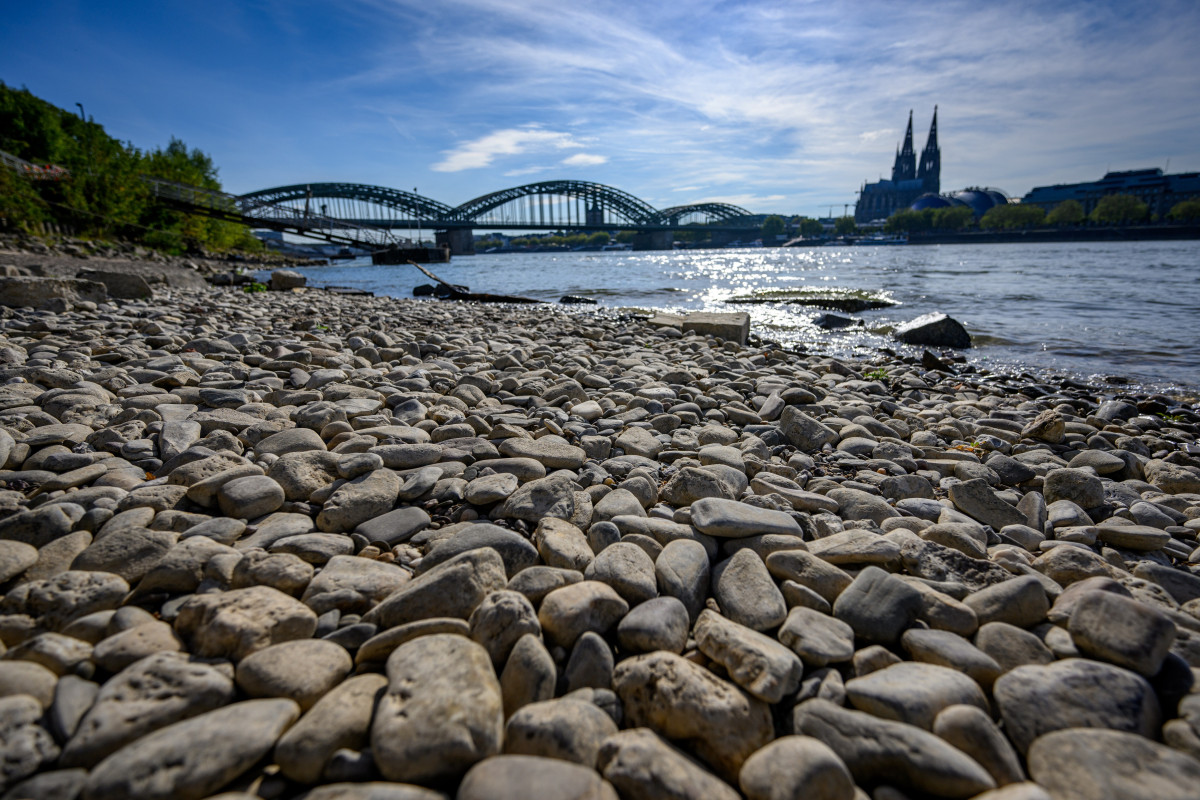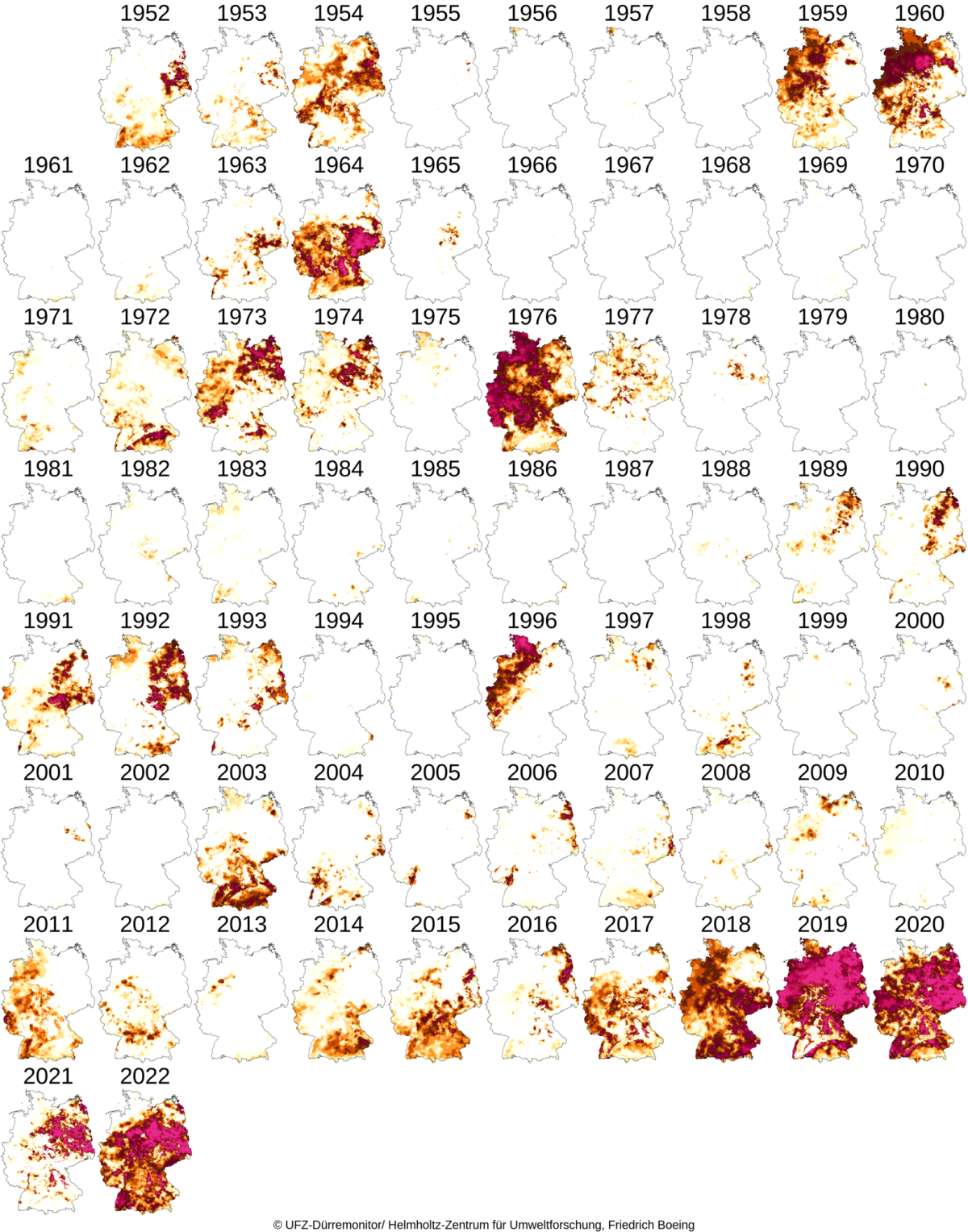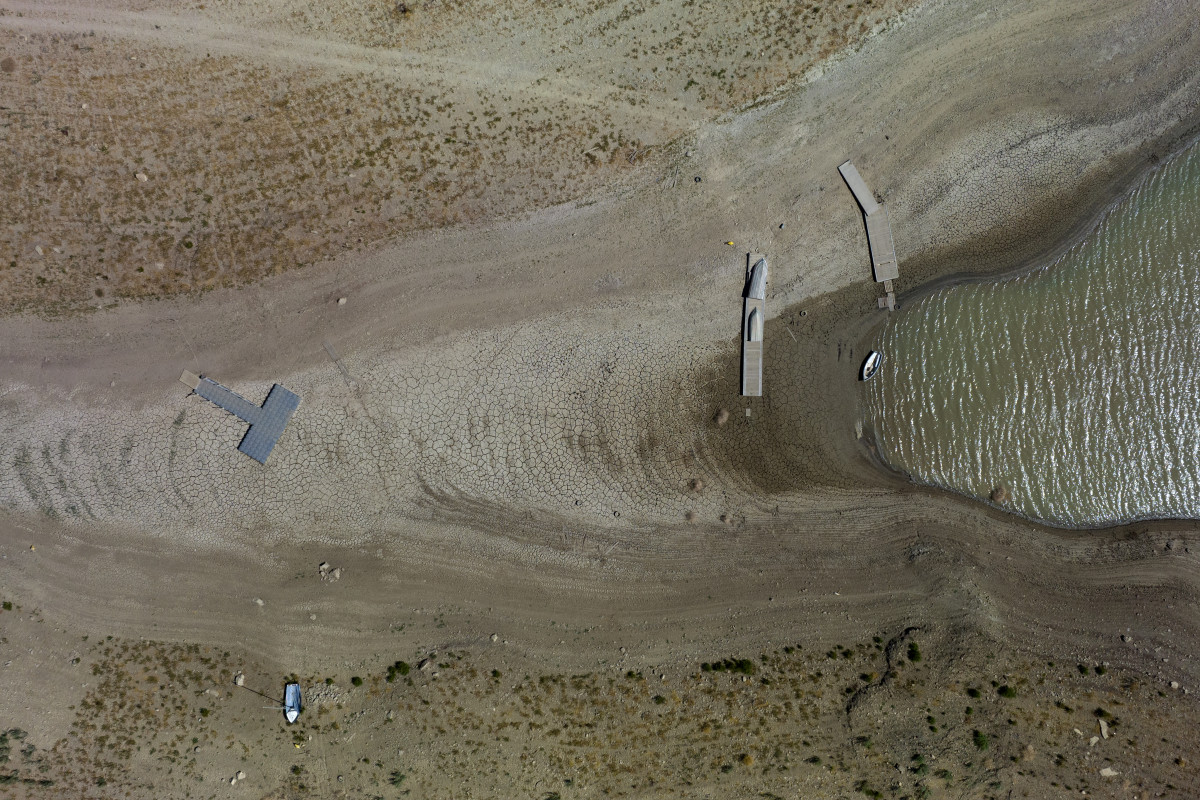Germany braces for heatwave impacts on health, economy and water supply
Germany is gearing up for another summer marked by heat and drought, as temperatures in June reached oppressively hot levels in many regions. The need for climate action is slowly inching back into the middle of the political debate, as citizens are feeling the initial effects of high temperatures and erratic precipitation this year, while districts begin to enforce restrictions on water use. Not only are biodiversity, agriculture, human health, water availability and forestry affected, but climate change could also impact the country’s economic recovery.
The first signs of a potentially very hot, very dry summer bring back flashbacks to 2018, when record-breaking temperatures compounded with extremely low precipitation caused heat-related deaths, crop failures, wildfires and infrastructural damages. Germany sits at the heart of the world’s fastest warming continent, where a string of extreme weather events in the past years have pushed adaptation to the forefront of climate policy.
Around this time last year, regional heat records in northern Germany, drought in many regions and large forest and field fires in the country’s east grabbed headlines. The trend is likely to continue, as seasonal climate predictions by the meteorological service DWD calculated that the period between June and August might once again be too warm and too dry compared to the reference period 1991 to 2020.
Scene set for summer of high temperatures
The month of June in Germany was 2.1 degrees warmer than the above reference period (3.1 degrees above the reference period 1961 to 1990) and, despite a wet spring, large areas of the country are already suffering from severe, extreme — and in some regions even exceptional — drought, according to the drought monitor of the Helmholtz Centre for Environmental Research.
The first heat warning of the season was declared in mid-June and, as summer temperatures increase and groundwater levels decrease, districts in the federal states of Saxony-Anhalt, Lower Saxony and North Rhine-Westphalia have taken preventive action by restricting water use. Environment minister Steffi Lemke called for industry to save water, saying that “the climate crisis is changing our lives and our economies” and large consumers must focus even more on the economical use of the resource.
Water levels in parts of the Rhine river dropped well below their 10-year average level – disrupting freight transport and sending a stark reminder of the 2018 drought, which affected 90 percent of German territory and is when the lowest water levels ever were recorded.
In Bavaria, municipalities have prohibited or restricted grilling due to the increased risk of wildfires, which spread faster in extremely dry vegetation. The cumulative burnt areas are higher than the national average between 2011 and 2022 for this time of year. Fire brigades across Germany’s southwest are gearing up with special vehicles, equipment and clothing, as outdoor fires require more versatile gear compared to urban ones. In 2022, forest fires cost the country over 600 million euros in damages to health, nature and the economy.
Looking beyond this summer, Brandenburg, one of Germany’s historically driest regions, is preparing to better deal with heat and drought, as well as heavy rain, with its first climate action plan. This comes at a time when scientists researching the state’s water balance have criticised supply plans, saying forecasts are flawed and much less of the resource will be available than currently projected.
The fastest warming continent
The rest of Europe faces a summer of extreme weather too. The 2022 summer drought and heat records were not a one-off, as the continent is warming faster than anywhere else in the world, the World Meteorological Organization warned. The western Mediterranean, which includes southern Spain, southern France and northern Italy, has been hit especially hard.
Heatwaves and persistently low rainfall have led to ‘severe drought’ in the region, which now faces low river flows and crop yields earlier than ever, according to a report by the EU’s JRC’s Copernicus Global Drought Observatory. The situation could become even more critical – especially in respect to water resources – if widespread warmer-than-average temperatures and the lack of rain continue, the authors warn.
This also affects hydropower producers, especially in southern Europe. They face another summer of low production, after droughts across the continent led to a significant downturn in generation in 2022. In France, a severe winter drought could affect energy production throughout the year, as power plants need river water for cooling. The country’s water supply is even more threatened than in 2022, when a prolonged drought led to throttled hydro and nuclear power production and prompted strict water saving measures, French environment minister Christophe Bechu said.
Drought did not only affect water supply: More than 30,000 hectares of forest went up in smoke in the country the past year. Moreover, heat-related deaths hit record highs, with public health agency SPF calling for structural change to better adapt to longer and more intense heatwaves.
The UK has also been hit by water shortages, as earlier-than-usual hot weather drove demand to record levels, Bloomberg reports. In fact, a river in England’s “wettest place” was almost completely dry by mid-June. The government needs to step up drought planning, as the national meteorological office declared the month of June the hottest in the country since records began over a century ago.
Heatwaves in Europe will become more frequent, more intense and will last longer, according to the IPCC’s sixth assessment report. Globally, 2023 has been branded as the year of climate anomalies, with the natural phenomenon of El Niño brewing, heat records being broken, wildfires raging uncontrollably, drought hitting hard and early, and ocean temperatures shattering heat records.
Setting the political agenda
There is growing consensus that not acting now to mitigate and adapt to the effects of climate change will be more expensive than acting. Still, Germany’s coalition government – comprised of the Social Democrats (SPD), the Green Party and the pro-business FDP – is challenged with turning ambitious climate targets into action and has been in discord over key climate policy for months.
Citizens see their daily lives increasingly affected by climate action and are concerned by the change and higher prices. They are also dissatisfied with the political implementation of the energy transition. Despite polls showing that most support climate action, and climate and energy remaining near or at the top of people’s agenda for the past five years, populist and far-right parties have gained support lately by seizing on people’s fears.
Inflation amid the energy crisis and the general cost of living – especially electricity, heating and transport – currently top the list of the biggest issues for voters. Regarding energy policy, however, environmental and climate protection have gained importance again for the first time since the start of the energy crisis, according to a survey by consultancy EY.
Amidst the year’s first heat waves, economic warnings, health concerns and environmental worries, the focus might change to climate again, just like it did during the 2019 and 2021 elections. This could become evident in the upcoming regional elections in the states of Bavaria and Hesse at the end of the year.
Is drinking water scarce in Germany?
Many German districts have restricted the filling up of pools, watering grounds (gardens, parks, sports facilities or agricultural land), or extracting water from wells and rivers, either temporarily or during the day if temperatures surpass a certain point.
While some areas enforce water restrictions, others are betting on so-called sensibilisation campaigns, urging citizens to become aware of their water consumption and, for example, take shorter showers.
“Prolonged periods of heat and drought are increasingly leading to regional water shortages in Germany,” the Association of Towns and Municipalities (DStGB) warned. While bottlenecks and restrictions are still the exception, proactive action and investments are needed so that it remains this way, water industry association DVGW said.
Almost one fifth (19%) of water utilities experienced bottlenecks in water resources in 2022, according to a DVGW survey. “More measures are needed at different levels to make the water supply fit for the future,” the association’s head, Wolf Merkel, urged. The development of new extraction areas, building new dams and underground water reservoirs, or expansion of the long-distance pipeline system, as well as interconnecting systems to neighbouring suppliers are all needed, according to the association.
The city of Berlin, where water supply is threatened by the country’s coal phase-out, is stepping up: its utility Berliner Wasserbetriebe (BWB) plans to invest around 6 billion euros to renovate groundwater wells and in better wastewater treatment by 2030.
For this year, should the summer be marked by low precipitation, environment senator Manja Schreiner (CDU) has not ruled out water rationing, newspaper Tagesspiegel reports. She is therefore drafting a contingency plan outlining where water may no longer be used if certain limit values are reached, according to the newspaper.
Falling groundwater levels are not only a problem for drinking water supply, but also for agriculture. In Bavaria, the government is promoting investment in water storage and irrigation systems for winegrowers, as most have relied on rainfall for decades and only a fraction can irrigate their vines artificially. Additionally, researchers are planting more heat-resistant or drought-tolerant crops – such as peanuts, sesame, beans and rice – across the state to help prepare agriculture for increased weather extremes.
Can ships still navigate major rivers?
After facing high temperatures and limited rainfall in 2022, the Rhine river – Germany’s most important shipping route for raw materials – experienced a substantial decrease in water levels.
This severely affected Germany’s coal transport in the midst of the energy crisis, when demand was particularly high. It also forced chemical industry heavyweight BASF to halt the production of plastics at one of its plants, which relied on the river for shipping supplies.
The first signs that this could be repeated within the next months have already begun: while water levels are still above critical levels for navigation, they are below the ten-year average for this time of year.
“Discharges and water levels on Germany’s major rivers are very likely to remain below average in the coming weeks, up until the beginning of August, and to decrease slowly overall,” Dennis Meißner, a scientist at the Federal Institute of Hydrology (BfG), which monitors Germany’s major rivers and produces hydrological forecasts, told Clean Energy Wire.
Water levels relevant for navigation could be too low towards the end of July, as the period between then and October is generally characterised by low water on free-flowing waterways, Meißner said. “However, it is not yet foreseeable whether extreme low water situations comparable to the years 2022 and 2018 will occur.”
Large companies like BASF have begun to adapt: the chemicals producer deployed a new freight vessel capable of coping with “extremely low” water levels without affecting its manoeuvrability.
What are the ripple effects of dropping water levels?
Climate change is putting pressure on the environmental and economic conditions of Germany’s major rivers, a 2021 report by hydrology institute BfG concluded. Without sufficient climate protection, low water level events could occur for over 45 days annually throughout the Rhine river by the end of the century, the authors concluded.
Lower water levels, especially in the middle and lower Rhine, “may pose considerable challenges for the logistics sector in the future,” BfG scientist Enno Nilson warned. This falls in line with Germany’s 2018 heat and drought risk analysis by the Federal Office for Civil Protection (BBK).
“While the visible consequences of the droughts can be seen relatively quickly in nature and agriculture, it wasn’t until 2018 that people associated a long drought with rising fuel prices, for example,” the BBK stated. “However, the lowered river levels posed a real challenge for inland navigation and transport.”
As ships are either cancelled or have to significantly reduce their load to navigate shallower waters, the transport of goods becomes more expensive and cannot be shifted entirely to rail, because capacity limits have already been reached on certain rail routes, the BBK concluded.
These transport disruptions cause a “significant and economically meaningful decrease of economic activity,” a 2020 analysis by economic research institute IfW Kiel found. Economists at Deutsche Bank Research have also warned that low water levels on the Rhine could slow down Germany’s economic recovery this year.
A less visible consequence of heat and drought
The full extent on the effects of climate change on human health in Germany is only just coming to light. Extreme heat and a growing number of hot days can increase the risk of preterm birth, lead to higher suicide rates and increase mortality overall.
Moreover, higher temperatures combined with more frequent floods mean Germany, and Europe, are facing a significant increase in disease-carrying mosquitos in previously unaffected areas, the disease control authority Robert Koch Institute (RKI) and the European Centre for Disease Prevention and Control (ECDC) have warned.
“The health consequences of heat are still underestimated. Both in the population and in politics,” Green parliamentarian Johannes Wagner said in a statement. “For far too long, nothing has happened.”
Germany’s health ministry is currently drafting the country’s first nationwide ‘heat protection plan’ – which was not considered necessary until last year – to prevent heat-related deaths and better prepare medical services and communities to deal with rising temperatures.
“In addition to health policy measures, we also need to redesign our environment: we need green spaces instead of sealed surfaces, fountains instead of car parks and trees instead of concrete deserts,” Wagner added, calling for all ministries to cooperate and exploit measures that are good for humans as well as the climate.
Extreme weather events such as the 2021 deadly floods in Germany’s west – one of the worst natural disasters in the country’s post-war history – are becoming more frequent and more intense as a result of climate change.
An imminent watershed moment
Temperatures are forecast to continue rising, together with an increase in dryer conditions and a decrease in rainfall. Without successful climate action globally, Germany too will face record temperatures, sinking groundwater levels, and drought on the one hand, with heavy precipitation within a very short amount of time on the other, which dry soils struggle to absorb and can lead to extreme flooding.
While it is hard to predict exactly how hard heat and drought will hit the country this summer, experts agree that water resources are under pressure and a readjustment of water policy is needed.
In the meantime, the country will continue to develop impact assessments and adaptation strategies, building on knowledge about the impacts of climate change and the measures to deal with them.





